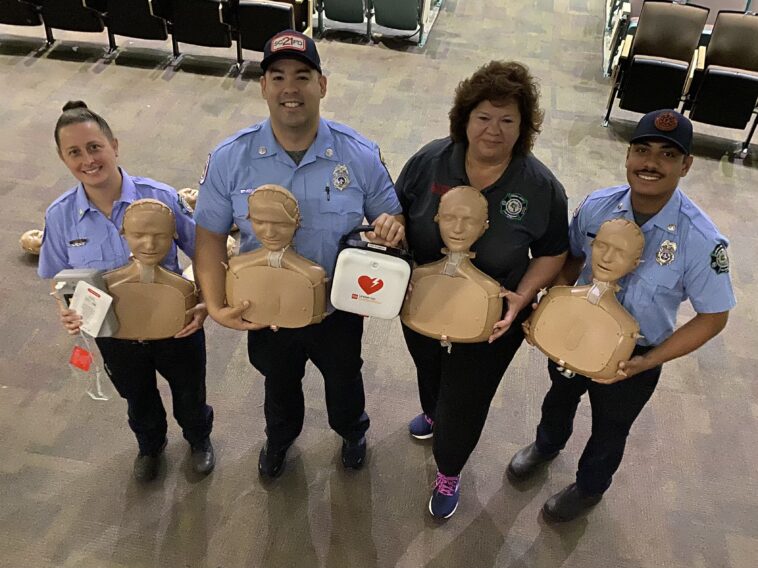Knowing when to act in a life-or-death situation can be stressful, so it is good to be prepared. If you are CPR-certified or carry Narcan, you can be a crucial asset in a medical emergency.
While knowing CPR is handy in any situation, using it when a loved one has used drugs may save a life. Sen. Rick Scott sent a letter on March 13 to all Florida School Superintendents notifying parents of a fentanyl crisis.
Florida was the second top nation for fentanyl overdose in 2021, according to the Florida Health Department. The “Safe Act” was introduced by Rep. Daniel Newhouse (R-WA) to help combat fentanyl trafficking in January.
Newtown also held a roundtable for the fentanyl crisis on March 16, according to a press release. The roundtable discussed the legislation, “William and James Wonacott Act of 2023”, and allowed parents of fentanyl victims to speak up.
While this crisis is affecting teens, it is still the leading cause of death for Americans ages 18-49. Prevention can be difficult, but there are steps you can take to help someone experiencing an overdose.
Know CPR
Becoming CPR certified in Florida has become easy, especially for teens. Florida HB 157 requires school districts to provide students in grades 9 and 11 basic training in first aid, including CPR.
Recently, Seminole County has partnered with Winter Springs High School to teach CPR to students who may be in a situation where it is needed. Students will learn CPR hands-on and watch videos on how to administer it.
Though most overdoses occur at home, it is still advised to look for the nearest automated external defibrillator.
Where to Get CPR Certified
There are many places you can go in Central Florida to learn CPR. The Orlando Fire Department offers a free 30-minute class to learn hands-on CPR and use an AED. There is also a four-hour CPR certification course with a donation of $20.
Narcan: What is it?
Narcan is a prescription nasal spray medicine used to reverse an opioid overdose by blocking the effects of the drugs. Unless there are no signs of breathing, Narcan is recommended to be administered before CPR when an overdose is suspected. If you are unsure which to perform first, ask your 911 operator.
Narcan is not harmless if a false overdose is present. Narcan is only harmful if an allergy to naloxone is present. An allergic reaction is not to be confused with opioid withdrawal symptoms Narcan may trigger.
Administering Narcan is the best way to save the life of someone who just had an opioid overdose. A real-world study concluded that 95% of overdoses were reversed with Narcan.
Know The Signs: How and When to Use It
If you suspect someone is overdosing, follow the steps carefully in administering Narcan. First, one must know the signs to know when to use it.
Signs of an opioid overdose can present in the form of unresponsiveness, slow or absent breathing, slow heartbeat, cold and clammy skin, small pupils, and blue nails and lips.
When administering Narcan nasal spray, first remove the Narcan from its container. Tilt the head of the unresponsive person back while they are lying down. After this, gently insert the Narcan nozzle into their nose until your fingers touch the bottom of their nose. Press lightly with your thumb to release the Narcan spray.
4 mg of Narcan is typically administered. If there is no response in the next 2 minutes, administer another dose of Narcan. It is not harmful.
After administration and CPR, the person will be put in a ‘recovery position’ while waiting for paramedics to arrive. The three steps to administer Narcan can be remembered as peel, place, and press.
Where to Get Narcan
Narcan is available at select pharmacies. Many universities, like the University of Central Florida, offer Narcan for free to students.
The FDA also just approved the first over-the-counter Naloxone nasal spray on March 29. It is to be sold directly to customers at gas stations, drug stores, convenience stores, grocery stores, and online.
If you’re not sure where to find it, it is best to call your local pharmacy to have Narcan available for worst-case scenarios.
Prevent the Overdose
It can be hard to curb drug use in a loved one. So, how can an overdose be prevented before it happens? Understanding the signs of drug use, especially in teens, may help stop the worst.
Partnership to End Addiction highlights what to look out for in your teen if you suspect drug use. While no teen likes intrusion in their life, it is better to make sure they may still have one.
Where to Reach Out
Substance abuse hotlines can be reached at 1-(800)-662-HELP (4357).
The Crisis Text Line can be reached by texting CONNECT to 741741.
Parents can go to the teen addiction guideline for more information.
If you suspect a loved one is overdosing, please immediately dial and call 911. Do not rely on CPR and Narcan without additional medical attention.



Comments